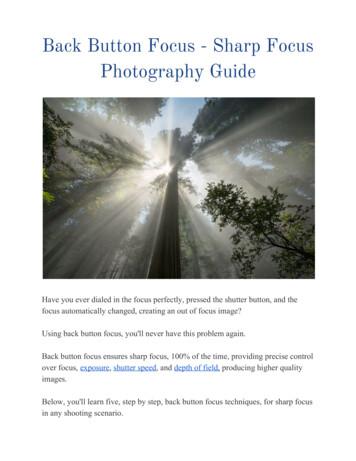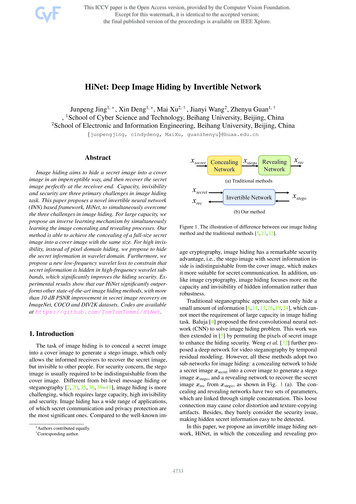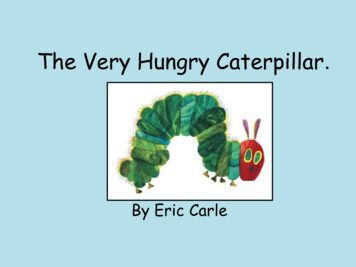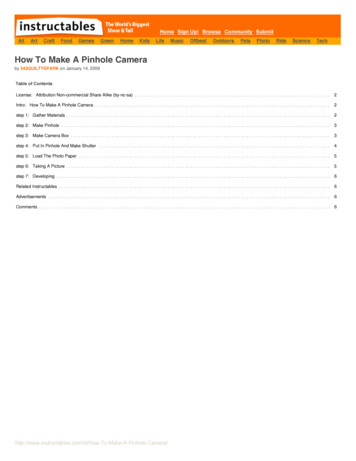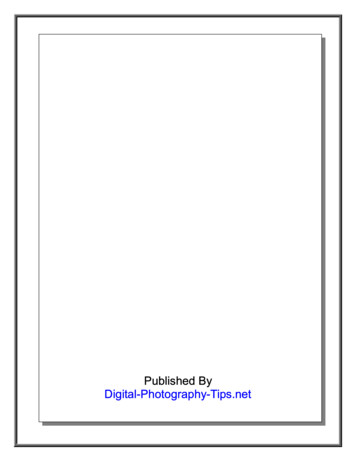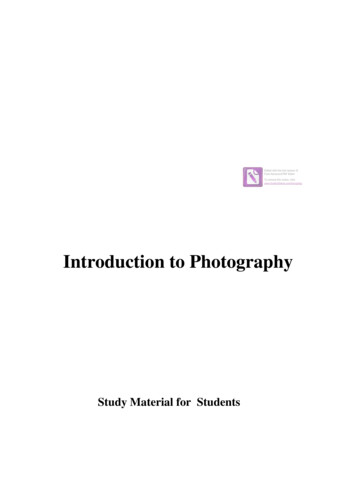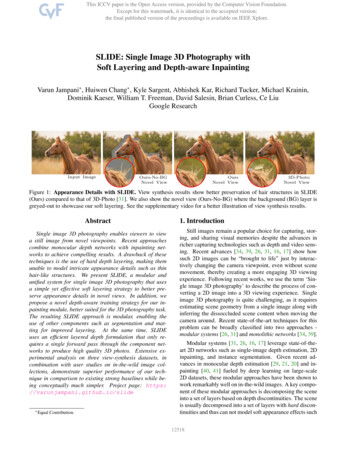
Transcription
SLIDE: Single Image 3D Photography withSoft Layering and Depth-aware InpaintingVarun Jampani , Huiwen Chang , Kyle Sargent, Abhishek Kar, Richard Tucker, Michael Krainin,Dominik Kaeser, William T. Freeman, David Salesin, Brian Curless, Ce LiuGoogle ResearchInput ImageOurs-No-BGNovel ViewOursNovel View3D-PhotoNovel ViewFigure 1: Appearance Details with SLIDE. View synthesis results show better preservation of hair structures in SLIDE(Ours) compared to that of 3D-Photo [31]. We also show the novel view (Ours-No-BG) where the background (BG) layer isgreyed-out to showcase our soft layering. See the supplementary video for a better illustration of view synthesis results.AbstractSingle image 3D photography enables viewers to viewa still image from novel viewpoints. Recent approachescombine monocular depth networks with inpainting networks to achieve compelling results. A drawback of thesetechniques is the use of hard depth layering, making themunable to model intricate appearance details such as thinhair-like structures. We present SLIDE, a modular andunified system for single image 3D photography that usesa simple yet effective soft layering strategy to better preserve appearance details in novel views. In addition, wepropose a novel depth-aware training strategy for our inpainting module, better suited for the 3D photography task.The resulting SLIDE approach is modular, enabling theuse of other components such as segmentation and matting for improved layering. At the same time, SLIDEuses an efficient layered depth formulation that only requires a single forward pass through the component networks to produce high quality 3D photos. Extensive experimental analysis on three view-synthesis datasets, incombination with user studies on in-the-wild image collections, demonstrate superior performance of our technique in comparison to existing strong baselines while being conceptually much simpler. Project page: https://varunjampani.github.io/slide EqualContribution.1. IntroductionStill images remain a popular choice for capturing, storing, and sharing visual memories despite the advances inricher capturing technologies such as depth and video sensing. Recent advances [34, 39, 26, 31, 16, 17] show howsuch 2D images can be “brought to life” just by interactively changing the camera viewpoint, even without scenemovement, thereby creating a more engaging 3D viewingexperience. Following recent works, we use the term ‘Single image 3D photography’ to describe the process of converting a 2D image into a 3D viewing experience. Singleimage 3D photography is quite challenging, as it requiresestimating scene geometry from a single image along withinferring the dissoccluded scene content when moving thecamera around. Recent state-of-the-art techniques for thisproblem can be broadly classified into two approaches modular systems [26, 31] and monolithic networks [34, 39].Modular systems [31, 26, 16, 17] leverage state-of-theart 2D networks such as single-image depth estimation, 2Dinpainting, and instance segmentation. Given recent advances in monocular depth estimation [29, 21, 20] and inpainting [40, 41] fueled by deep learning on large-scale2D datasets, these modular approaches have been shown towork remarkably well on in-the-wild images. A key component of these modular approaches is decomposing the sceneinto a set of layers based on depth discontinuities. The sceneis usually decomposed into a set of layers with hard discontinuities and thus can not model soft appearance effects such12518
as matting. See Figure 1 (right) for an example novel viewsynthesis result from 3D-Photo [31], which is a state-of-theart single image 3D photography system.In contrast, monolithic approaches [34, 39] attempt tolearn end-to-end trainable networks using view synthesislosses on multi-view image datasets. These networks usually take a single image as input and produce a 3D representation of a scene, such as point clouds [39] or multi-planeimages [34], from which one could interactively render thescene from different camera viewpoints. Since these networks usually decompose the scene into a set of soft 3Dlayers [34] or directly generate 3D structures [39], they canmodel appearance effects such as matting. Despite beingelegant, these networks usually perform poorly while inferring disoccluded content and have difficulty generalizing toscenes out of the training distribution, a considerable limitation given the difficulty in obtaining multi-view datasetson a wide range of scene types.In this work, we propose a new 3D photography approach that uses soft layering and depth-aware inpainting.We refer to our approach as ‘SLIDE’ (Soft-Layering andInpainting that is Depth-aware). Our key technique is asimple yet effective soft layering scheme that can incorporate intricate appearance effects. See Figure 1 for an example view synthesis result of SLIDE (Ours), where thin hairstructures are preserved in novel views. In addition, we propose an RGBD inpainting network that is trained in a noveldepth-aware fashion resulting in higher quality view synthesis. The resulting SLIDE framework is modular, and allows easy incorporation of state-of-the-art components suchas depth and segmentation networks. SLIDE uses a simple two-layer decomposition of the scene and requires onlya single forward pass through different components. Thisis in contrast to the state-of-the-art approaches [31, 26],which are modular and require several passes through somecomponents networks. Moreover, all of the components inthe SLIDE framework are differentiable and can be implemented using standard GPU layers in a deep learning toolbox, resulting in a unified system. This also brings ourSLIDE framework closer to single network approaches. Wemake the following contributions in this work: We propose a simple yet effective soft layering formulation that enables synthesizing intricate appearance detailssuch as thin hair-like structures in novel views. We propose a novel depth-aware technique for trainingan inpainting network for the 3D photography task. The resulting SLIDE framework is both modular and unified with favorable properties such as only requiring asingle forward computation with favorable runtime. Extensive experiments on four different datasets demonstrate the superior performance of SLIDE in terms of bothquantitative metrics as well as from user studies.2. Related WorkClassical optimization methods have been applied tothe view synthesis task [13, 18, 27], but the most recent approaches are learning-based. Some works [8, 15]have predicted novel views independently, but to achieveconsistency between output views, it is preferable to predict a scene representation from which many output viewscan be generated. Such representations include pointclouds [39, 24], meshes [31], layered representations suchas layered depth images [30, 35] and multi-plane images(MPIs) [44, 7, 32], and implicit representations such asNeRF [25, 23, 5]. Much research in view synthesis has centered on the task of interpolation between multiple images,but most relevant to our work are methods focusing on thevery challenging task of extrapolation from a single image.Single Network Approaches. For narrow baselines, Srinivasan et al. predict a 4D lightfield directly [33], while Liand Kalantari [19] represent a lightfield as a blend of twoVariable-depth MPIs. For larger baselines, Single-viewMPI [34] applies the MPI representation to the single image case, and SynSin [39] uses point clouds and applies aneural rendering stage, which enables it to generate contentoutside the original camera frustum. These learning-basedmethods are trained end-to-end, with held-out views fromnovel viewpoints being used for supervision via a reconstruction loss. Training data can be obtained from light-fieldcameras [19, 33] or multi-camera rigs [7], or derived fromphoto collections [24] or videos of static scenes [44]. A keydrawback of these approaches is their poor generalization toin-the-wild images.Depth-based 3D Photography. Another approach to singleimage 3D photography is to build a system combining depthprediction and inpainting modules with a 3D renderer. Fordepth estimation from a single image, a variety of learningbased methods [6, 21, 10] exist. The MiDaS system [29]achieves excellent results by training on frames from 3Dmovies [29] as well as other depth datasets. Non-learningbased approaches for inpainting apply patch matching andblending [2, 14] or diffusion [4, 38], but since arbitraryamounts of training data can be generated simply by obscuring random sections of input images, this task is a naturaltarget for learning-based approaches. Recent methods propose augmenting convolutional networks with contextualattention mechanisms such as DeepFill’s gated convolutions[41, 42] or a coherent semantic attention layer [22], andapplying patch-based discriminators for GAN-based training as well as reconstruction losses. Another recent work,HiFill [40] takes a residual-based approach to inpaint evenvery high resolution images.In the context of 3D Photography, inpainting will typically operate on a more complex representation than a simple image, and systems may need to inpaint depth as wellas texture. The method of Shih et al. [31] introduces12519
ADIInput ImageSoft FG VisibilitySDisparity1. Depth EstimationD I AIT FG Layer(RGBDA)D̃I Soft Dis-occlusions(Inpaint Mask)BG Layer(Inpainted RGBD)2. Soft Layering3. Depth-aware InpaintingNovel View4. Layered RenderingFigure 2: SLIDE Overview. SLIDE is a modular and unified framework for 3D photography and consists of the four maincomponents of depth estimation, soft layering, depth-aware RGBD inpainting and layered rendering. In addition, one canoptionally use foreground alpha mattes (not shown in this figure) to improve the layering.an extension of the layered depth image format. The system performs multiple inpainting steps in which edges anddepth, as well as images, are inpainted within different image patches. The system of Niklaus et al. [26] performsinpainting on rendered novel images and projects the inpainted content back into a point cloud to augment its representation. This latter system also adds an additional network to refine the estimated depth, and incorporates instance segmentation to ensure that people and other important objects in the scene do not straddle depth boundaries.These systems are somewhat complex, requiring multiplepasses of the same network (e.g., inpainting). As mentionedearlier, another key drawback of these approaches is that thelayering is hard and can not incorporate intricate appearance effects in layers. Our approach follows the depth-plusinpainting paradigm but operates on a simple yet effectivetwo-layer representation that enables the incorporation ofsoft appearance effects. In addition, due to our simple twolayer soft formulation, we only need a single forward passthrough different component networks; thus, it can be considered as a single unified network while being modular.3. MethodsSLIDE Overview. As illustrated in Figure 2, our 3D photography approach, SLIDE, has four main components:1. monocular depth estimation, 2. soft layering, 3. depthaware RGBD inpainting, and 4. layered rendering. Froma given still image I Rn 3 with n pixels, we first estimate depth D Rn . We then decompose the scene intotwo layers via our soft-layering formulation where we estimate foreground (FG) pixel visibility A Rn and inpainting mask S Rn in a soft manner. Using these, weconstruct the foreground RGBDA layer with the input image I, its corresponding disparity D and the pixel visibilitymap A; and the background RGBD layer with the inpaintedRGB image I and the inpainted disparity map D̃. We thenconstruct triangle meshes from the two disparity maps, textured with I and A for the foreground and I for the background, render each into a target viewpoint, and compositethe foreground rendering over the background rendering. Inaddition, we can optionally use foreground alpha mattes toimprove layering as our soft layering enables easy incorporation of alpha-mattes.3.1. Monocular Depth EstimationGiven an RGB image I Rn 3 with n pixels, we firstestimate a disparity (inverse depth) map D Rn 1 using aCNN. We use the publicly released MiDaS v2 [29] networkΦD for monocular inverse depth prediction. Specifically,the MiDaS model is trained on a large and diverse set ofdatasets to achieve zero-shot cross dataset transfer. It proposes a principled dataset mixing strategy and a robust scaleand shift invariant loss function that results in predicted disparity maps up to an unknown scale and shift factor. The final output of ΦD is a normalized disparity map D [0, 1]n ,which is then used in the subsequent parts of the SLIDEpipeline. To reduce missing foreground pixels and noise inlayering (Section 3.2), we do slight Gaussian blur and maxpool the disparity map. One could use any other monoculardepth network in our framework. We choose MiDaS for itsgood generalization across different types of images.3.2. Soft LayeringA key technical contribution in SLIDE is estimating layers in a soft fashion so that we can model partial visibilityeffects across layers. As illustrated in Figure 2, layeringalso connects the depth and inpainting networks making ita crucial component of SLIDE. Our soft layering has twomain components: 1. estimating soft pixel visibility of theforeground layer, and 2. estimating a soft disocclusion mapthat is used for background RGBD inpainting.12520
Without FG VisibilityWith FG VisibilityFigure 3: Foreground Pixel Visibility. Rendering anRGBD layer without pixel visibility (left) leads to stretchytriangles, whereas rendering with pixel visibilities (right)enables seeing through to the background (represented withblack pixels here).Image with DisparitySoft DisocclusionsSoft OcclusionsFigure 4: Soft Disocclusions and Occlusions. At eachpoint (x, y) in an image, we compare disparity differencesacross horizontal and vertical scan lines to compute soft dissocclusion and occlusion maps.Soft FG Pixel Visibility. We estimate visibility at eachimage pixel, which enables us to see through to the background layer when rendering novel-view images. Figure 3(left) shows a single RGBD layer, represented by the givenRGB image and the corresponding estimated disparity, rendered as a textured triangle mesh into a new viewpoint.Stretching artifacts appear at depth discontinuities. To address these artifacts, we construct a visibility map A thathas lower values (higher transparency) at depth discontinuities – lower visibility in proportion to changes in disparity– later allowing us to see through these discontinuities tothe (inpainted) background layer. More formally, given theestimated disparity map D for a given image I, we computethe FG pixel visibility map A [0, 1]n as:2A e β D ,(1)where is the Sobel gradient operator and β R is a scalarparameter. Thus the pixel visibility varies inversely withdisparity gradient magnitude. Low FG visibility (A 0)corresponds to high FG pixel transparency. Figure 3 (right)shows a novel-view rendering with the pixel visibility mapA multiplied against the original rendering; black regionsindicate areas that are now transparent in the foregroundlayer. Note that modelling this FG visibility in a soft manner allows SLIDE to easily incorporate segmentation basedsoft alpha mattes into layering, as we discuss in Section 3.3.Soft Disocclusions. In addition to foreground visiblity, weneed to construct a mask to guide inpainting in the background layer. Intuitively, we need to inpaint the pixels thathave potential to be dissoccluded when the camera movesaround. The relationship between (dis-)occlusion and disparity is well known [3, 37, 36], and we make use of thisrelationship to compute soft disocclusions from the estimated disparities. The disparity-occlusion relationship inthese prior works is derived in the stereo image setting,where we have metric disparity, and the occlusions are defined with respect to a second camera. In our case, we onlyhave relative depth (disparity), but we can still assume somemaximum camera movement and introduce a scalar parameter that can scale the disparities accordingly. Consider thebackground region at pixel location (x, y) behind the giraffe’s head in Figure 4 (left). This background region hasthe potential to be dissoccluded by the foreground if thereexists a neighborhood pixel (xi , yj ) whose disparity difference with respect to the foreground pixel at (x, y) is greaterthan the distance between those pixels’ locations. More formally, the background pixel at (x, y) will be dissoccluded if (xi ,yj ) D(x,y) D(xi ,yj ) ρK(xi ,yj ) ,(2)where ρ is a scalar parameterthatscalesthedisparitydifp(xi x)2 (yj y)2 is the disference. K(xi ,yj ) tance between (xi , yj ) to the center pixel location (x, y).In simpler terms, a background pixel is more likely to bedissoccluded if the foreground disparity at that point ishigher compared to that of surrounding regions. For oursoft-layering formulation, we convert the above step function into a soft version resulting in a soft disocclusion mapS [0, 1]n : S(x,y) tanh γmax(xi ,yj ) D(x, y) D(xi , yj ) (3) ρK(xi ,yj ) ,where γ is another scalar parameter that controls the steepness of the tanh activation. In addition, we apply a ReLUactivation on top of tanh to make S positive. ComputingS with the above equation requires computing pairwise disparity differences between all the pixel pairs in an image.Since this is computationally expensive, we constrain thedisparity difference computation to a fixed neighborhood(m pixels) around each pixel ((xi , yj ) N(x,y) , where Nis the m pixel neighborhood of (x, y)). This is still computationally expensive for reasonable values of m ( 30).So, we constrain our disparity difference computation alonghorizontal and vertical scan lines as illustrated with red linesin Figure 4 (left). We implement pairwise disparity differences and also pixel distances along horizontal and verticalneighborhoods with efficient convolution operations on disparity and pixel coordinate maps. This results in an effective feed-forward computation of dissocclusion maps usingstandard deep learning layers. For efficiency, we can alsocompute the disocclusion map on a downsampled disparitymap and then upsample the resulting map to the desired resolution. Figure 4 (middle) shows the soft dissocclusion map12521
aImagecbDisparitydSoft FG VisibilityOnly Depth-basedForegroundAlpha MatteefSoft FG Visibility Soft FG VisibilityOnly Matte-based Depth and MatteFigure 5: Layering With Alpha Mattes. Depth-based FG visibility (c) can not capture hair-like structures. Computing FGvisibility (e) based on FG alpha matte (d) and then incorporating it into visibility can capture fine details (f).that is estimated using this technique. In a similar fashion,we obtain a soft occlusion map Ŝ [0, 1]n as shown in Figure 4 (right) by replacing ‘ ’ with ‘ ’ in Eqn. 2 and modifying Eqn. 3 accordingly. We make use of the occlusion anddisocclusion maps in inpainting training (Section 3.4).3.3. Improved Layering with SegmentationConsider the input image shown in Figure 5(a), whichhas thin hair structures. The soft FG visibilities (Eqn. 1)purely based on depth discontinuities will not preserve suchthin structures in novel views. For this image, we can seethat these fine structures are not captured in the disparitymap and are therefore also missed in the visibility map (Figure 5 (b) and (c), resp.). To address this shortcoming, weincorporate FG alpha mattes – computed using state-of-theart segmentation and matting techniques – into our layering.Our soft layering can naturally incorporate soft mattes.We first compute FG segmentation using the U2Netsaliency network [28], which we then pass to a matting network [9] to obtain FG alpha matte M [0, 1]n as shown inFigure 5 (d). Note that we can not directly use these alphamattes as visibility maps, as we want visibility to be low(close to zero) only around the FG object boundaries. So,we dilate (max-pool) the alpha matte (denoted as M̄ ) andthen subtract the original alpha matte from it. Figure 5 (e)shows 1 (M̄ M ). The resulting matte-based FG visibility map will only have low visibility around FG alpha matte.We then compute the depth-matte based FG visibility mapA′ [0, 1]n as: A′ A (1 (M̄ M )(1 Ŝ)), whereA denotes the depth-based visibility map (Eqn. 1, Figure 5(c)) and Ŝ denotes the occlusion map, with example shownin Figure 4 (right). (1 Ŝ) term reduces the leakage ofmatte-based visibility map onto too much background andthe multiplication with depth-based visibility A ensures thatthe final visibility map also accounts for depth discontinuities. Figure 5 (f) shows the depth-matte based FG visibilitymap A′ , which captures fine hair-like structures while alsorespecting the depth discontinuities.3.4. Depth-Aware RGBD InpaintingTo avoid exposing black background pixels when thecamera moves, as shown in Figure 3, we inpaint the disoccluded regions S and incorporate the result into our background layer. Inpainting such disocclusions is differentfrom traditional inpainting problems because the modelneeds to learn to neglect the regions in front of each tobe-inpainted pixel. In Figure 6, we show sample resultsof two state-of-the-art image inpainting methods [42, 40]to inpaint the disoccluded regions. While they synthesizegood textures and are even capable of completing the basketball and the dog’s head, this is actually undesirable inour pipeline, as we want to inpaint the BG, not the FG. Inaddition, we perform RGBD inpainting which is in contrastto the existing RGB inpainting networks.One of the key challenges in training our inpainting network using disocclusion masks (see Figure 4 (middle) foran example mask) is that we do not have ground-truth background RGB or depth for these regions in single imagedatasets. To overcome this, we instead make use of occlusion masks (see Figure 4 (right)) that surround the objects as inpaint masks during training. Since we have GTbackground RGB along with estimated background depthwithin occlusion masks, we can directly use these masksalong with the original image as GT for training.The intuition behind inpainting the occlusion mask is topretend that the FG is larger than its actual size along itssilhouette. We find training on these masks helps the modellearn to borrow from the regions with larger depth values. Inother words, such training with occlusion masks makes inpainting depth-aware. Training with this type of mask only,however, is insufficient as the model has not learned to inpaint thin objects or perform regular inpainting. We addressthis by randomly adding traditional stroke-shape inpaintingmasks used in standard inpainting training following Deepfillv2 [42], which enables the model to learn to inpaint thinor small objects. So our dataset consists of two types of inpainting masks: occlusion masks and random strokes. Inthis way, any single image dataset can be adapted to beused in training our inpainting model without requiring anyannotations. We show examples from our custom trainingdataset in the supplement. See Figure 6 for a sample inpainting result with more in the supplementary material.We employ a patch-based discriminator D to discriminate between real and generated results, and apply an adversarial loss to the inpainting network, as in Deepfillv2[42]. So the objective loss for the inpainting network is aweighted sum of the reconstruction loss – the L1 distancebetween inpainted results and ground truth – and the hingeadversarial loss. More details about network training and12522
InputDisparityInpaint MaskHiFillDeepFillv2OursFigure 6: Depth-aware Inpainting. Inpainting techniques (HiFill [40] and DeepFill [42]) borrow information from both FGand BG. Our depth-aware inpainting mostly borrows information from the BG making it more suitable for 3D photography.architectures are discussed in the supplementary material.It is worth contrasting our inpainting approach with thatof 3D-Photo inpainting [31], which is also depth-aware andits dataset is annotation-free. One big difference is thatour inpainting is global while 3D-Photo inpaints on localpatches based on depth edges. Due to this, our inferenceonly requires a single-pass and is relatively fast, while 3Dphotos requires multi-stage processing and iterative floodfill like algorithms to generate the inpainting masks perpatch, which is relatively time-consuming.3.5. Layered RenderingGiven the foreground and background images and disparity maps, we can now render each into a novel view andcomposite them together. The soft layering stage producesa foreground layer comprised of the input image I, visibility map A, and disparity D. We back-project the disparitymap in the standard way to recover a 3D point per pixel andconnect points that neighbor each other on the 2D pixel gridto construct a triangle mesh. We then texture this mesh withI and A and render it into the novel viewpoint; A is resampled, but not used for compositing during rendering at thisstage. The novel viewpoint is given by a rigid transformation T from the canonical viewpoint, and the result of thisrendering step is a new foreground RGB image IT and visibility AT . The output of the inpainting stage is backgroundimage I and disparity D̃. We similarly construct a triangle and project into the novelmesh from D̃, texture it with I,view to generate new background image I T . Finally, wecomposite foreground over background to obtain the finalnovel-view image IT :IT AT IT (1 AT )I T .(4)We use a TensorFlow differentiable renderer [12] to generate IT and I T to enable a unified framework.4. ExperimentsWe quantitatively evaluate SLIDE on three multi-viewdatasets: RealEstate10k [44] (RE10K), Dual-Pixels [11]and Mannequin-Challenge (MC) [20] that provide videosor multi-view images of a static scene. In addition, we perform user studies on the photographs from Unsplash [1].Baselines and Metrics. We quantitatively comparedwith three recent state-of-the-art techniques, for whichcode is publicly available: SynSin [39], Single-imageMPI [34] (SMPI) and 3D-Photo [31]. SynSin and SMPIare end-to-end trained networks that take a single image asinput and generate novel-view images. 3D-Photo, on theother hand, is a modular approach that is not end-to-endtrainable. Like SLIDE, 3D-Photo uses a disparity networkcoupled with a specialized inpainting network to generatenovel-view images. For fair comparison, both 3D-Photoand SLIDE techniques use MiDaSv2 [29] disparities. But,unlike SLIDE, 3D-Photo does not model fine structures,like fur and hair, on foreground silhouettes. We refer toour model that does not use alpha mattes as ‘SLIDE’ andthe one that does as ‘SLIDE with Matte’.Following SMPI [34], we quantitatively measured theaccuracy of the predicted target views with respect tothe ground-truth images using three different metrics ofLPIPS [43], PSNR and SSIM. Since SLIDE and severalbaselines do not perform explicit out-painting (in-filling thenewly exposed border regions), we ignore a 20% border region when computing the metrics.Results on RealEstate10K. RealEstate10K (RE10K) [44]is a video clips dataset with around 10K YouTube videosof static scenes. We use 1K randomly sampled video clipsfrom the test set for evaluations. We follow [34] and usestructure-from-motion and SLAM (Simultaneous Localization and Mapping) algorithms to recover camera intrinsicsand extrinsics along with the sparse point clouds. As in [34],we also compute the point-visibility from each frame. Forthe evaluation, we randomly sample a source view fromeach test clip and consider the following 5th (t 5) and10th (t 10) frames as target views. We compute evaluation metrics with respect to these target views. Table 1shows that SLIDE performs better or on-par with currentstate-of-the-art techniques with respect to all the evaluationmetrics. The improvement is especially considerable in theLPIPS perceptual metric, indicating that SLIDE view synthesis preserves the overall scene content better than existing techniques. Figure 7 shows sample visual results.SMPI [34] generate blurrier novel views; and SLIDE usually preserves the structures better around the occlusion12523
GT Target ViewSMPI3D-PhotoSLIDE (Ours)Dual-PixelsMCMCRE10KInput ImageFigure 7: Sample Visual Results on Benchmarks. Novel view synthesis results of different techniques: Single-imageMPI [34], 3D-Photo [31] and SLIDE (Ours) on sample images from RE10K [44], MC [20] and Dual-Pixels [11] datasets.Input ImageSLIDE3D-PhotoSLIDE with MatteFigure 8: Visual Results on in-the-wild Images. View synthesis results on sample Unsplash dataset [1] images that we usein user studies. SLIDE and SLIDE with Matte approaches can more faithfully represent thin hair-like structures compared to3D-Photo [31]. See the supplementary video for better illustration of results.boundaries where the scene elements on images move withrespect to each other when camera moves. On all the 3benchmark datasets, we do not see further improvements byincorporating FG matting into SLIDE (SLIDE with Matte),as these dataset images do not have predominant foregroundobjects with thin hair-like structures.Results on Dual-Pixels. Dual-Pixels [11] is a multi-viewdataset taken with a custom-made, hand-held capture rigconsisting of 5 mobile phones. That is, each scene is captured simultaneously with 5 cameras that are separated by amoderate baseline. We evaluate SLIDE and other baselineson the 684 publicly available test scenes. For each scene,we consider one of the side views as input and consider theremaining 4 views as target views. Compared to RE10K,dual-pixels data consists of more challenging scenes cap-tured in diverse settings. Table 2 shows the quantitativeresu
gle image 3D photography’ to describe the process of con-verting a 2D image into a 3D viewing experience. Single image 3D photography is quite challenging, as it requires estimating scene geometry from a single image along with inferring the dissoccluded scene content when moving the c




